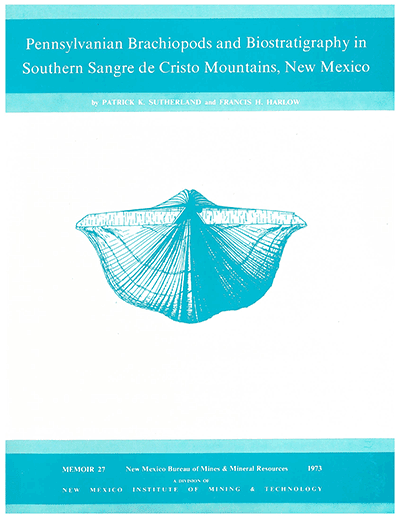
Memoir 27—Pennsylvanian brachiopods and biostratigraphy in southern Sangre de Cristo Mountains, New Mexico

By P. K. Sutherland and F. H. Harlow, 1973, 173 pp., 81 figs., 18 plates, 3 appendices, 1 index.
Correlates local stratigraphy with mid-continent. Proposes three new genera. Describes 29 new species and subspecies. Includes 21 measured sections. Companion piece to Memoir 11 issued 1963. Descriptive statistics and specimen measurements on microfiche in appendix. Pennsylvanian marine strata are exposed extensively in the southern Sangre de Cristo Mountains of north-central New Mexico. The area studied extends from Santa Fe and Lamy in the south to Taos in the north. The Pennsylvanian strata show marked lateral changes in thickness and lithology from a thin, predominantly carbonate shelf facies in the south to a thick, predominantly terrigenous trough facies in the north. The combined thickness of the La Pasada and Alamitos Formation is 2,200 ft in the south; the Flechado and Alamitos Formations are greater than 6,500 ft in the north. The Morrow, Atoka, and Des Moines Series are particularly well represented.
Analysis of the regional Pennsylvanian stratigraphy of the area would have been impossible without a detailed study of the brachiopod faunas that form the most common element in the megafaunas of the Pennsylvanian System. Correlations in the middle and upper parts of the Pennsylvanian (upper Atokan to Virgilian) were aided by detailed information provided by the fusulinids, where they occur, and in the lower part of the section by the conodonts.
This study provides a better understanding of the evolutionary relationships of the brachiopod faunas in the lower parts of the Pennsylvanian System. It documents for the first time the marked evolutionary changes that occur in many brachiopod groups between the Morrow and lower Des Moines Series, and to some extent between the Morrowan and Atokan. In contrast, rates of change are comparatively slow in most brachiopod groups higher in the Pennsylvanian, in the Des Moines, Missouri, and Virgil Series.
Ninety-four species belonging to 42 genera of brachiopods are described. Three new generic names are proposed, Sandia, Tesuquea, and Zia. Twenty-nine new species and subspecies are described: "Orbiculoidea" youngi, Rhipidomella trapezoida, Derbyia bonita, Neochonetes henryi, N. whitei, Mesolobus profundus, Kozlowskia montgomeryi, Desmoinesia nambeensis, Sandia brevis, S. santafeensis, Pulchratia? pustulosa, P.? picuris, Buxtonia grandis, Tesuquea formosa, Horridonia? daltonensis, Linoproductus devargasi, L. pumilus, Zia novemexicana, Composita umbonata, Cleiothyyridina milleri, Neospirifer tewaensis, Anthracospirifer curvilateralis tanoensis, A. c. chavezae, A. mcalesteri, Spiriferellina ceres, Punctospirifer morrowensis, Beecheria daltonensis, B. stehlii, and B. gerberi.
$10.00
Buy
Now
Also available as a free download.
Download
| File Name | Size | Last Modified |
|---|---|---|
| Memior_27.pdf | 17.13 MB | 01/19/2021 09:27:05 AM |
| Memior_27.zip | 31.58 MB | 01/19/2021 09:27:51 AM |
| Pocket Contents: | ||
| Memoir_27_Appendices.pdf | 9.81 MB | 01/19/2021 09:27:17 AM |
| Memoir_27_Figure_8.pdf | 102 KB | 01/19/2021 09:27:26 AM |
| Memoir_27_Figure_9.pdf | 5.62 MB | 01/19/2021 09:27:39 AM |



